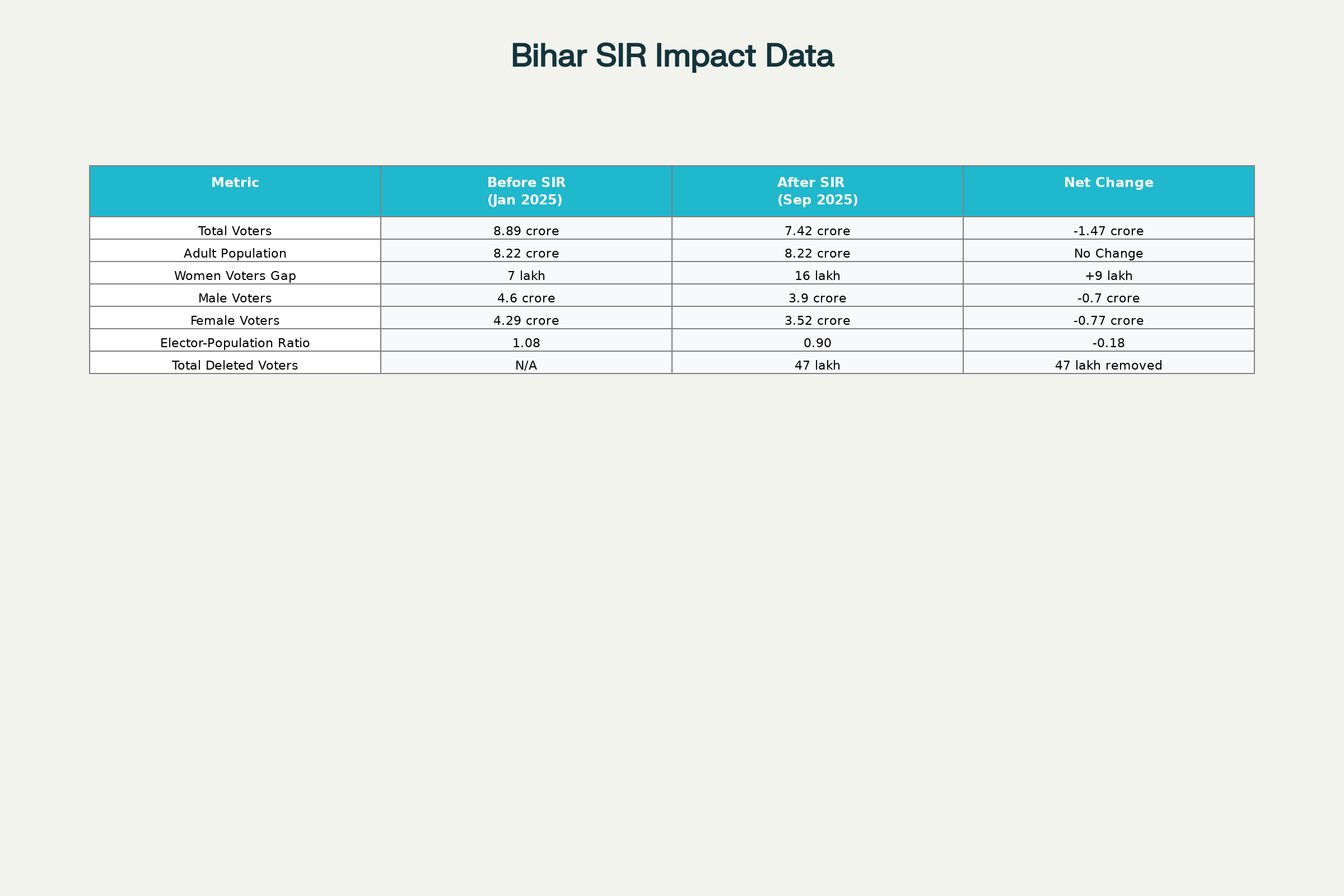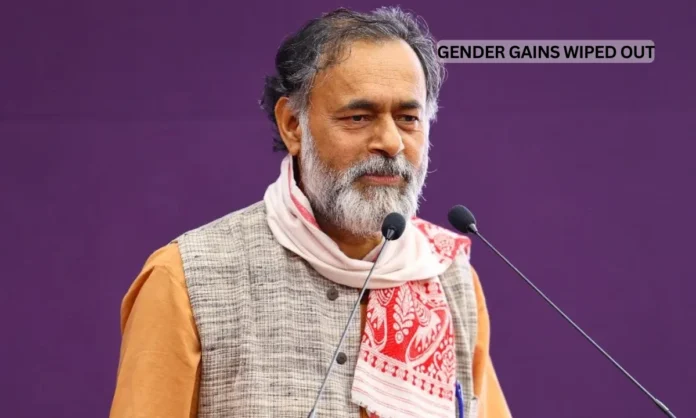Key Highlights
- Special Intensive Revision removed 47 lakh adults from Bihar’s electoral rolls, including 16 lakh women voters in a single exercise
- Gender ratio gains of 10 years have been completely wiped out, with women’s representation dropping from 7 lakh gap to 16 lakh gap
- Supreme Court has ordered free legal aid for 3.7 lakh individuals excluded from voter lists and directed state legal services to assist appeals
Opening Overview
The Supreme Court has become the battleground for a critical electoral rights dispute as activist and election analyst Yogendra Yadav challenges Bihar’s controversial Special Intensive Revision of voter lists. The Bihar Special Intensive Revision has eliminated 47 lakh adults from electoral rolls, with women bearing disproportionate impact as 16 lakh female voters were removed in what Yadav describes as the complete erasure of decade-long progress in gender representation. This massive deletion exercise has transformed what the Election Commission calls a necessary cleaning process into what petitioners argue represents systematic disenfranchisement targeting vulnerable communities.
The Bihar Special Intensive Revision controversy has exposed fundamental tensions between electoral integrity measures and universal adult franchise rights. With Bihar’s adult population estimated at 8.22 crore according to official projections, the final electoral roll contains only 7.42 crore voters, creating an unprecedented 80 lakh gap between eligible adults and registered voters. This demographic disconnect has prompted intense Supreme Court scrutiny, with Justice Surya Kant and Justice Joymalya Bagchi expressing concern about potential mass disenfranchisement while acknowledging past electoral roll inflation problems that required correction through the Bihar Special Intensive Revision process.
Demographics and Data Reveal Systemic Exclusion Pattern
The Bihar Special Intensive Revision has produced alarming demographic shifts that extend far beyond routine electoral maintenance. Official Election Commission data reveals that Bihar’s projected adult population for 2025 stands at 8.22 crore, yet the final electoral roll contains only 7.42 crore voters, representing a dramatic reduction from the previous 8.89 crore registered voters. This statistical reality demonstrates that approximately 10 percent of Bihar’s adult population remains absent from democratic participation, raising serious questions about the Bihar Special Intensive Revision methodology and implementation.

Bihar Special Intensive Revision: Electoral Statistics Comparison (January vs September 2025)
Gender-specific analysis reveals particularly troubling patterns within the Bihar Special Intensive Revision outcomes. The exercise resulted in 7 lakh more women voters being deleted compared to men, with young women under 40 disproportionately marked as “permanently shifted” despite insufficient evidence of actual migration. Districts like Gopalganj experienced severe gender imbalances, with women’s voter numbers falling by nearly 15 percent while men dropped by only 7.8 percent during the Bihar Special Intensive Revision. This demographic skew suggests systemic issues in how the process handled women’s electoral registration, particularly affecting marriage migration patterns and re-registration processes that traditionally impact female voters.
The Bihar Special Intensive Revision has also revealed concerning regional variations that challenge claims of uniform application. While the exercise was justified partly on concerns about illegal migrants in border districts, the actual deletion patterns show minimal removals in the Seemanchal region near international borders where such issues were allegedly concentrated. Instead, the highest deletion rates occurred in constituencies with significant Dalit and Muslim populations, suggesting the Bihar Special Intensive Revision may have inadvertently targeted marginalized communities rather than addressing specific demographic irregularities.
Supreme Court Intervention and Legal Framework Analysis
The Supreme Court’s involvement in the Bihar Special Intensive Revision case represents unprecedented judicial scrutiny of electoral roll revision processes. Justice Surya Kant and Justice Joymalya Bagchi have expressed particular concern about the Election Commission’s claim that zero individuals challenged their exclusion from voter lists, questioning whether adequate notification procedures were followed during the Bihar Special Intensive Revision. The bench has ordered State Legal Services Authority to deploy para-legal volunteers and government lawyers to assist the 3.7 lakh individuals who may seek appeals against their exclusion from the process.
Yogendra Yadav’s presentation to the Supreme Court highlighted what he termed “three toxic weapons” employed during the Bihar Special Intensive Revision: systemic exclusion, structural exclusion, and targeted exclusion possibilities. His detailed analysis showed that errors in the final voter list included names written in Tamil and Kannada scripts within Bihar’s Hindi-speaking constituencies, along with blank entries for spouse names and addresses, indicating procedural irregularities during the Bihar Special Intensive Revision implementation. These technical deficiencies have strengthened petitioners’ arguments that the revision process lacked adequate quality controls and verification mechanisms.
The Election Commission’s defense, presented by senior advocate Rakesh Dwivedi, has focused on characterizing petitioner claims as “false” and arguing that excluded individuals failed to submit required enumeration forms during the Bihar Special Intensive Revision period. However, the Commission’s assertion conflicts with demographic evidence showing that Bihar historically maintained inflated voter rolls with elector-to-population ratios exceeding 107 percent, necessitating correction but raising questions about the scale and methodology of deletions undertaken through the Bihar Special Intensive Revision. The Supreme Court’s directive for free legal assistance acknowledges the complexity of individual cases while ensuring due process rights remain protected throughout the appeal process.
Electoral Integrity Versus Democratic Participation Debate
The Bihar Special Intensive Revision controversy has crystallized fundamental tensions between maintaining electoral integrity and ensuring universal adult franchise rights. Election Commission officials argue that the revision addressed longstanding problems of inflated voter rolls, with Bihar’s elector-to-population ratio previously reaching unsustainable levels of 1.08 compared to the national average of 0.69. The Bihar Special Intensive Revision aimed to create more accurate demographic representation by removing duplicate entries, deceased voters, and individuals who had permanently relocated, bringing Bihar’s electoral statistics closer to realistic population projections.
Critics of the Bihar Special Intensive Revision process argue that the methodology employed was overly broad and failed to distinguish between legitimate corrections and mass disenfranchisement. Research by advocacy groups suggests that Bihar contained approximately 77 lakh excess voters before the revision, indicating that some correction was necessary. However, the Bihar Special Intensive Revision’s removal of 47 lakh voters exceeded these estimates and disproportionately affected women, young adults, and minority communities who face greater barriers to re-registration and documentation requirements.
The Bihar Special Intensive Revision debate has broader implications for electoral administration across India, as the Election Commission has indicated plans to implement similar intensive revisions in other states with suspected demographic irregularities. Opposition parties and civil society organizations fear that the Bihar model could be replicated to selectively disenfranchise opposition strongholds or marginalized communities under the guise of electoral cleanup. The Supreme Court’s handling of this case will likely establish precedents for balancing administrative efficiency with constitutional rights to democratic participation, making the Bihar Special Intensive Revision controversy a defining moment for Indian electoral jurisprudence.
Long-term Implications for Democratic Representation
The Bihar Special Intensive Revision case extends beyond immediate electoral concerns to address fundamental questions about democratic representation and administrative accountability. The controversy has highlighted systemic weaknesses in India’s voter registration infrastructure, where periodic cleanup exercises risk excluding legitimate voters due to inadequate verification processes and insufficient outreach to vulnerable populations. The Bihar Special Intensive Revision’s impact on women voters particularly concerns gender rights advocates, who argue that marriage-related migration patterns and patriarchal documentation practices create structural barriers that intensive revision processes may inadvertently amplify.
Future electoral cycles in Bihar will test whether the Bihar Special Intensive Revision achieved its stated objectives of creating more accurate voter rolls without compromising democratic participation. The Election Commission must demonstrate that the 80 lakh individuals excluded from electoral participation either were genuinely ineligible or received adequate opportunity for re-registration through accessible processes. Civil society monitoring of upcoming registration drives and voter education campaigns will be crucial for assessing whether the Bihar Special Intensive Revision represents a temporary correction or signals a concerning shift toward restrictive electoral administration.
The Supreme Court’s ultimate ruling on the Bihar Special Intensive Revision will establish important precedents for balancing administrative discretion with constitutional rights across India’s diverse demographic landscape. Legal experts anticipate that the decision will clarify procedural requirements for future electoral roll revisions, including notification standards, appeal mechanisms, and quality control measures. The case outcome will influence how election commissions nationwide approach demographic irregularities while ensuring that cleanup exercises strengthen rather than undermine democratic participation for all eligible citizens through lessons learned from the Bihar Special Intensive Revision experience.
Closing Assessment
The Bihar Special Intensive Revision controversy represents a critical juncture for Indian electoral democracy, where administrative efficiency goals have collided with fundamental voting rights protections. Yogendra Yadav’s Supreme Court challenge has successfully highlighted the human cost of large-scale electoral roll revisions, particularly the erasure of decade-long progress in women’s political participation. The court’s intervention through free legal aid provisions acknowledges that electoral cleanup exercises must include robust safeguards against mass disenfranchisement, especially for vulnerable populations who face systemic barriers to documentation and re-registration following the Bihar Special Intensive Revision.
The Bihar Special Intensive Revision debate ultimately reflects broader tensions within India’s electoral system between maintaining accurate demographic representation and ensuring universal adult franchise remains accessible to all eligible citizens. While the Election Commission’s concerns about inflated voter rolls contained legitimate technical merit, the implementation methodology and disproportionate impact on marginalized communities suggest that future revisions require more nuanced approaches that prioritize inclusion alongside accuracy. The Supreme Court’s final judgment will determine whether the Bihar Special Intensive Revision model becomes a template for electoral administration nationwide or serves as a cautionary example of administrative overreach that undermines democratic participation rights.


